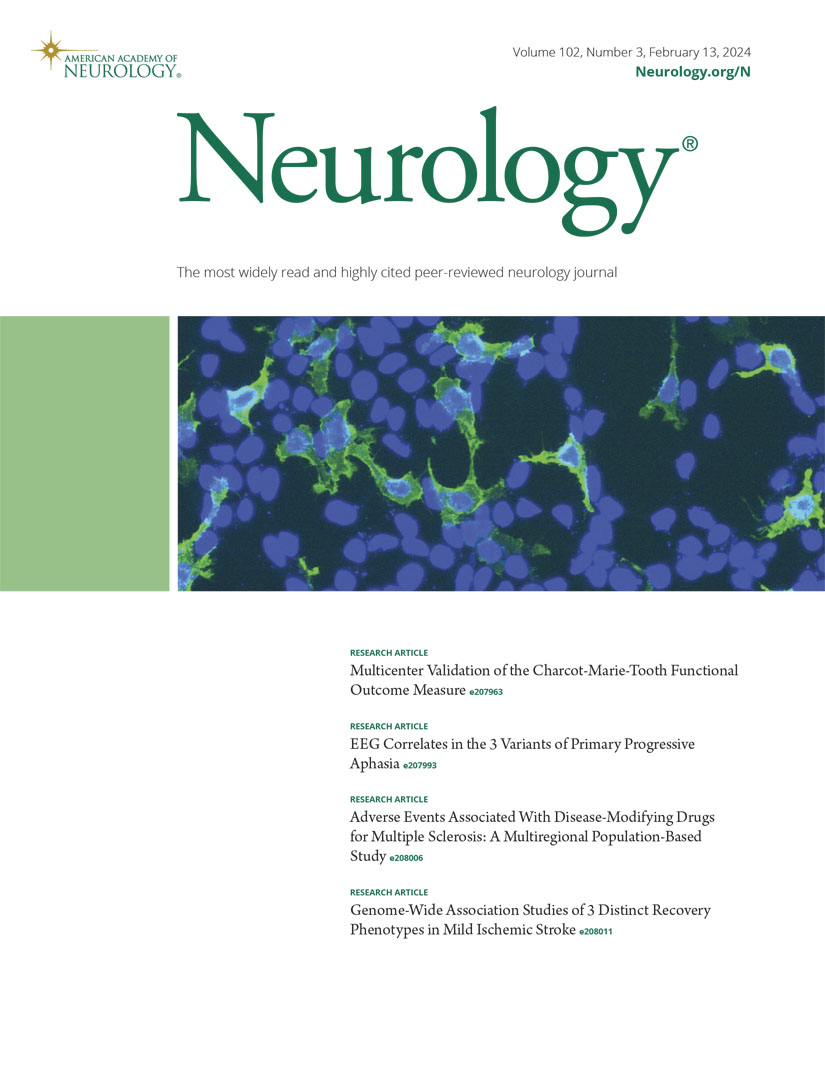加速生物衰老与痴呆的关联以及脑结构的中介作用:来自一项纵向研究的发现。
IF 7.7
1区 医学
Q1 CLINICAL NEUROLOGY
引用次数: 0
摘要
背景与目的生物衰老与痴呆之间的关系及其潜在机制仍然有限。本研究旨在探讨生物年龄(BA)与痴呆的关系,并探讨其潜在的神经生物学机制。方法本研究使用来自英国生物银行的数据,这是一项前瞻性的纵向研究。我们纳入了基线时未被诊断为痴呆的参与者。采用klemera - double法生物年龄(KDM-BA)和PhenoAge算法从临床特征评估BA。采用载脂蛋白E (APOE) ε4基因型和多基因风险评分(PRSs)评估痴呆的遗传风险。采用Cox比例风险回归模型估计BA与遗传风险和BA与痴呆的联合效应的相关性。此外,使用中介分析评估脑结构(灰质体积[GMV]、皮质平均厚度和皮质表面积)在BA和痴呆之间的关联中的潜在作用。结果共纳入280,918例受试者,平均年龄56.80岁,女性54.59%。在中位13.58年的随访中,记录了4770例痴呆病例。KDM-BA加速和PhenoAge加速每增加一个SD与14%相关(风险比[HR] = 1.14;95% CI 1.10-1.18)和15% (HR = 1.15;(95%可信区间1.12-1.19)痴呆的发病率较高。携带APOE ε4且表型age加速最快的个体与携带APOE ε4且表型age加速最快的个体相比,痴呆风险最高(HR = 4.20, 95% CI 3.69 ~ 4.78),且交互作用显著(p交互作用< 0.001)。我们没有发现PRS对BA加速与痴呆之间的关联有显著的调节作用(KDM-BA加速的Pinteraction = 0.347, PhenoAge加速的Pinteraction = 0.279), APOE ε4对KDM-BA加速与痴呆之间的关联也没有显著的调节作用(Pinteraction = 0.212)。中介分析表明,识别出的GMV、皮质平均厚度和皮质表面积部分介导了脑损伤加速与痴呆发生率之间的关联,比例中介率为6.64% ~ 17.98%。高级BA可能是发生痴呆的潜在危险因素。这种风险可能是通过大脑结构的广泛减少来调节的。本文章由计算机程序翻译,如有差异,请以英文原文为准。
Associations of Accelerated Biological Aging With Dementia and the Mediation Role of Brain Structure: Findings From a Longitudinal Study.
BACKGROUND AND OBJECTIVES
The association between biological aging and dementia, as well as the underlying mechanism, remains limited. The aim of this study was to investigate the relationships of biological age (BA) with incident dementia and examine the underlying neurobiological mechanisms.
METHODS
This study used data from the UK Biobank, a prospective longitudinal study. We included participants free of diagnosed dementia at baseline. BA was evaluated from clinical traits using the Klemera-Doubal method biological age (KDM-BA) and PhenoAge algorithms. Genetic risk of dementia was assessed using the apolipoprotein E (APOE) ε4 genotype and polygenic risk scores (PRSs). Cox proportional hazard regression models were used to estimate the associations of BA and the combined effect of genetic risk and BA with dementia. In addition, the potential roles of brain structures (gray matter volume [GMV], cortical mean thickness, and cortical surface area) in the associations between BA and dementia were evaluated using mediation analysis.
RESULTS
A total of 280,918 participants (mean age 56.80 years, 54.59% female) were enrolled in this study. Over a median follow-up of 13.58 years, 4,770 cases of dementia were recorded. Every SD increase in KDM-BA accelerations and PhenoAge accelerations was associated with a 14% (hazard ratio [HR] = 1.14; 95% CI 1.10-1.18) and 15% (HR = 1.15; 95% CI 1.12-1.19) higher incidence of dementia, respectively. Individuals with APOE ε4 and highest PhenoAge accelerations had the highest risk of dementia (HR = 4.20, 95% CI 3.69-4.78) compared with those with non-APOE ε4 and lowest PhenoAge accelerations, with significant interaction effect (Pinteraction < 0.001). We did not find significant modification effects of PRS on the associations between BA accelerations and dementia (Pinteraction = 0.347 for KDM-BA acceleration, Pinteraction = 0.279 for PhenoAge acceleration), as well as APOE ε4 on the association between KDM-BA accelerations and dementia (Pinteraction = 0.212). Mediation analysis showed that the identified GMV, cortical mean thickness, and cortical surface area partly mediated the association between BA accelerations and incident dementia, with proportion-mediated percentage ranging from 6.64% to 17.98%.
DISCUSSION
Advanced BA may be a potential risk factor of incident dementia. The risk is possibly mediated through the widespread reduction of brain structures.
求助全文
通过发布文献求助,成功后即可免费获取论文全文。
去求助
来源期刊

Neurology
医学-临床神经学
CiteScore
12.20
自引率
4.00%
发文量
1973
审稿时长
2-3 weeks
期刊介绍:
Neurology, the official journal of the American Academy of Neurology, aspires to be the premier peer-reviewed journal for clinical neurology research. Its mission is to publish exceptional peer-reviewed original research articles, editorials, and reviews to improve patient care, education, clinical research, and professionalism in neurology.
As the leading clinical neurology journal worldwide, Neurology targets physicians specializing in nervous system diseases and conditions. It aims to advance the field by presenting new basic and clinical research that influences neurological practice. The journal is a leading source of cutting-edge, peer-reviewed information for the neurology community worldwide. Editorial content includes Research, Clinical/Scientific Notes, Views, Historical Neurology, NeuroImages, Humanities, Letters, and position papers from the American Academy of Neurology. The online version is considered the definitive version, encompassing all available content.
Neurology is indexed in prestigious databases such as MEDLINE/PubMed, Embase, Scopus, Biological Abstracts®, PsycINFO®, Current Contents®, Web of Science®, CrossRef, and Google Scholar.
 求助内容:
求助内容: 应助结果提醒方式:
应助结果提醒方式:


